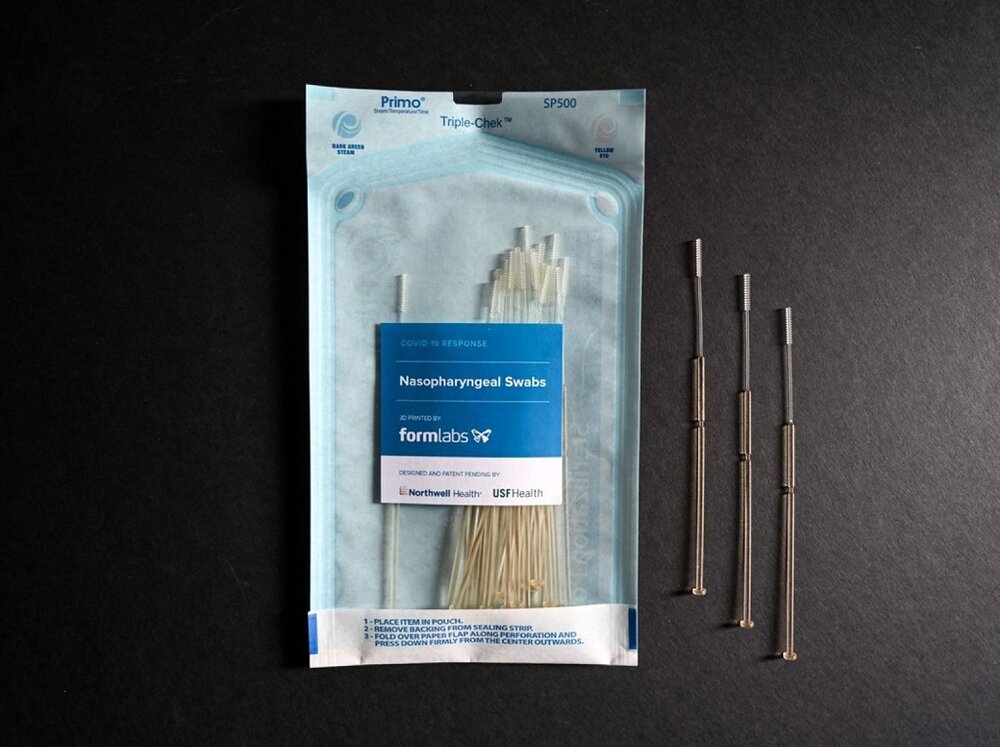![3D printed nasopharyngeal swabs for COVID-19 testing [Image: PrintedSwabs.org]](https://fabbaloo.com/wp-content/uploads/2020/05/printedswabs_img_5eb0652690bbe.jpg)
3D printed nasopharyngeal swabs for COVID-19 testing [Image: PrintedSwabs.org]
With so many 3D printing efforts arising to fight the pandemic, it takes a lot for a new solution to stand out. This is that story.
For 3D printing to be effective in any application, but especially in medical use where human lives are at stake, certain factors must come into play — validation and collaboration key among them.
PrintedSwabs.org
An expert-led consortium has just gone live, bringing together the efforts of the 3D printing industry together with academia and medical enterprises to supply millions of 3D printed COVID-19 test swabs.
“Validated manufacturers around the country are now poised to rapidly produce up to 4 million 3D printed swabs per week, starting today. Hospital incident commanders can connect with manufacturers directly and contact their state Emergency Management Agencies to request immediate supplies for their growing needs,” PrintedSwabs.org explains.
FDA-registered 3D printed nasopharyngeal test swabs are now being produced at volume in a series of ISO13485 facilities, available through one single source for rapid fulfillment for medical providers.
Carbon, EnvisionTEC, Formlabs, HP, OPT, and Origin are all validated manufacturers coming together to offer their ISO-certified production facilities to 3D print these swabs, which all offer “FDA registered swab designs with superior or equivalent efficacy to flocked swabs.”
Consortium Efforts
We’ve been following initiatives from consortium members Carbon and Formlabs as they’ve engaged in volume production of nasopharyngeal swabs, and HP as they continue to boost their 3D printing business’ efforts to counter COVID-19 spread.
To see all of these names together with other leading 3D printing companies all indeed working together — this is what is needed.
And it goes well beyond these familiar names. A longer — but not exhaustive — list of the collaborators in this nasal swab task force includes: Wyss Institute, Harvard Medical School/Beth Israel Deaconess Medical Center, Stanford Medical Center, University of South Florida (USF) Medical School, Ohio State University, Carbon, HP, Formlabs, Desktop Metal, and the US Army Natick Soldier Systems Laboratory.
The joint work began some weeks ago, including file sharing in a GitHub repository, which describes the work:
“Large-scale virological testing for SARS-CoV-2, causative agent of COVID-19, has resulted in an acute shortage in NP swabs across the United States. Ad hoc groups from academia and industry have formed to address this crisis. This repository organizes output from these efforts.
The purpose is to update medical professionals and manufacturers.”
Organizing this output has been of great importance, as there have seemed to be at times too many cooks in the kitchen, as it were. While the spirit of 3D printer operators has been in the right place, centralized organization has been largely lacking. Working together and gathering resources into a single source is of great importance, as medical professionals need to know where they can turn for reliable, safe, validated, effective solutions.
The effort is also keen to underscore safety measures for nasopharyngeal (NP) swabs being made, explaining:
“For those with in-house 3D printing capacity who are in the direst need, USF has graciously made an STL file available, along with instructions that you should read first. However, we strongly caution that NP swabs are a serious undertaking that can carry risk to patients if not carefully evaluated, by professionals, at multiple steps of development and use (e.g. design, materials), as the groups listed here have been doing. If you can work with a known manufacturer, you are strongly encouraged to do so instead of printing your own swabs.
All readers are reminded that swabs are an FDA Class 1 exempt medical device not suitable for ‘garage testing.’ ENT, ER, and ID personnel do not need more work removing foreign bodies from/repairing damage to/treating infections in nasal cavities.
At this point we discourage randomly printing/testing STL files; instead please see results from testing sites above (esp. USF, if you have your own printing capacity).”
Importantly, two stand-out sentiments also pop out here:
“Progress has been possible only because of the extraordinary openness and sharing of everyone involved, an inspirational and selfless victory over ego and related temptations.”
And
“We are driven by a single, common goal: stopping this pandemic.”
NP Swab Access
To gain access to the swabs available through this effort for COVID-19 testing, medical personnel are directed to the consortium’s newly-launched website:
“Hospital incident commanders in need of COVID-19 test swabs will be able to connect with manufacturers directly through the new website, www.PrintedSwabs.org, and contact their state Emergency Management Agencies to request immediate supplies for their growing needs.”
A single form can be filled out at PrintedSwabs.org, and contact information is also provided for the manufacturers involved.
It takes a lot in general for me to do an actual double take at a press release (at least for a positive reason). When this one hit my inbox, I might have actually punched my fist in the air, because this is exactly the kind of action we need right now.
Via PrintedSwabs.org

